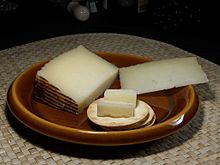Zamorano cheese facts for kids
Zamorano (which means Queso zamorano in Spanish) is a special cheese from Spain. It's made in the Zamora region. This cheese is unique because it's made from sheep's milk. It's a hard cheese, usually aged for about six months. Workers often turn the cheeses and rub them with olive oil. This gives Zamorano its dark, special color. The cheese gets its amazing taste from the local sheep breeds. These include the "Churra" and Castilian sheep. The cold, damp weather and long aging time also help make it delicious.
Quick facts for kids Zamorano |
|
|---|---|
 |
|
| Country of origin | Spain |
| Source of milk | sheep |
| Texture | Hard |
| Weight | 11 kg (24 lb) |
| Certification | PDO |
Contents
What Makes Zamorano Cheese Special?
Zamorano cheese has a very creamy and sweet taste. It also has a savory flavor with a little bit of a spicy kick. Some people describe it as strong and nutty. The cheese is shaped like a cylinder. It has a cool zigzag pattern on its rind. This pattern is similar to other Spanish cheeses like Castellano or Manchego. It also tastes a bit like them. A whole Zamorano cheese usually weighs about 11 kilograms.
Protected Quality
Zamorano cheese is protected by something called a "Denominación de Origen." This is a special label that makes sure the cheese is made correctly. It sets rules for how it's produced, what ingredients are used, and how long it must age. This helps keep the cheese's quality and unique character.
The Long History of Zamorano Cheese
Cheese has been a part of human food for a very long time. People in the Zamora region likely started making cheese when they first settled down. They began raising animals like sheep. We know this because old tools called "encellas" have been found. These tools were used to shape and drain cheese. They are from the Bronze Age and are now in the Museum of Zamora.
Ancient Cheese Making
This tradition of making cheese by hand continued for many centuries. A Roman writer named Columella wrote about how cheese was made. He described the common ways to make and store cheese back then. Later, many old laws and town rules in Zamora mentioned cheese. These rules talked about how to sell cheese and even how to make it.
Cheese in Old Contracts
Cheese was also part of old agreements between lords and their workers. Sometimes, workers would give cheese to their lords as part of their payment. Records from churches and monasteries also show payments made with cheese. This proves how important cheese was in the region.
Modern Recognition
Even in 1752, records show that many sheep were raised in Zamora. These records also mention a lot of cheese being made. Cheese was even given as gifts for festivals and to important people. All these historical facts show that cheese making has a very long and proud history in Zamora. The great quality of milk from local sheep and the careful way Zamorano cheese is made have made it famous. Today, it's one of the most popular foods from the Zamora region.
See also
 In Spanish: Queso zamorano para niños
In Spanish: Queso zamorano para niños
Images for kids


